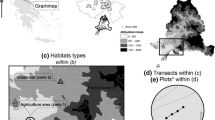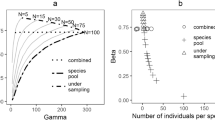Abstract
Diversity partitioning is becoming widely used to decompose the total number of species recorded in an area or region \((\gamma )\) into the average number of species within samples \((\alpha )\) and the average difference in species composition \((\beta )\) among samples. Single-value metrics of \(\alpha \) and \(\beta \) diversity are popular because they may be applied at multiple scales and because of their ease in computation and interpretation. Studies thus far, however, have emphasized observed diversity components or comparisons to randomized, null distributions. In addition, prediction of \(\alpha \) and \(\beta \) components using environmental or spatial variables has been limited to more extensive data sets because multiple samples are required to estimate single \(\alpha \) and \(\beta \) components. Lastly, observed diversity components do not incorporate variation in detection probabilities among species or samples. In this study, we used hierarchical Bayesian models of species abundances to provide predictions of \(\alpha \) and \(\beta \) components in species richness and composition using environmental and spatial variables. We illustrate our approach using butterfly data collected from 26 grassland remnants to predict spatially nested patterns of \(\alpha \) and \(\beta \) based on the predicted counts of butterflies. Diversity partitioning using a Bayesian hierarchical model incorporated variation in detection probabilities by butterfly species and habitat patches, and provided prediction intervals for \(\alpha \) and \(\beta \) components using environmental and spatial variables.

Similar content being viewed by others
References
Anderson MJ, Crist TO, Chase JM, Vellend M, Inouye BD, Freestone AL, Sanders NJ, Cornell HV, Comita LS, Davies KF, Harrison SP, Kraft NJB, Stegen JC, Swenson NG (2011) Navigating the multiple meaning of beta diversity: a roadmap for the practicing ecologist. Ecol Lett 14:19–28
Bliss CI, Fisher RA (1953) Fitting the negative binomial distribution to biological data. Biometrics 9:176–200
Brooks SP, Gelman A (1998) General methods for monitoring convergence of iterative simulations. J Comput Graph Stat 7:434–455
Caughley G, Grice D (1982) A correction factor for counting emus from the air, and its application to counts in western australia. Aust Wildl Res 9:253–259
Celeux G, Forbes F, Robert C, Titterington D (2006) Deviance information criteria for missing data models. Bayesian Anal 1:651–674
Clark JS (2007) Models for ecological data. Princeton University Press, New Jersey
Cressie NAC (1993) Statistics for spatial data (revised edition). Wiley, New York
Crist TO, Veech JA (2006) Additive partitioning of rarefaction curves and species-area relationships: unifying \(\alpha \)-, \(\beta \)- and \(\gamma \)-diversity with sample size and habitat area. Ecol Lett 9:923–932
Crist TO, Veech JA, Gering JC, Summerville KS (2003) Partitioning species diversity across landscapes and regions: a hierarchical analysis of \(\alpha,\,\beta \), and \(\gamma \)-diversity. Am Nat 162:734–743
Dorazio RM, Royle JA, Soderstrom B, Glimskar A (2006) Estimating species richness and accumulation by modeling species occurrence and detectability. Ecology 87:842–854
Famoye F (1993) Restricted generalized poisson regression model. Commun Stat Theory Methods 22:1335–1354
Felix F, Singh KP (2006) Zero-inflated generalized poisson regression model with an application to domestic violence data. J Data Sci 4:117–130
Gelfand AE, Silander JA, Wu S, Latimer A, Lewis P, Rebelo AG, Holder M (2006) Explaining species distribution patterns through hierarchical modeling. Bayesian Anal 1:41–92
Gelman A (2006) Prior distributions for variance parameters in hierarchical models (comment on article by Browne and Draper). Bayesian Anal 1:515–534
Gelman A, Rubin DB (1992) Inference from iterative simulation using multiple sequences. Stat Sci 7:457–511
Hall DB, Zhang Z (2004) Marginal models for zero inflated clustered data. Stat Model 4:161–180
Hofer G, Wagner HH, Herzog F, Edwards PJ (2008) Effects of topographic variability on the scaling of plant species richness in gradient dominated landscapes. Ecography 31:131–139
Jost L (2007) Partitioning diversity into independent alpha and beta components. Ecology 88:2427–2439
Kraft NJB, Comita LS, Chase JM, Sanders NJ, Swenson NG, Crist TO, Stegen JC, Vellend M, Boyle B, Anderson MJ, Cornell HV, Davies KF, Freestone AL, Inouye BD, Harrison SP, Myers JA (2011) Disentangling the drivers of beta-diversity along latitudinal and elevational gradients. Science 333:1755–1758
Lambert D (1992) Zero-inflated poisson regression, with an application to defects in manufacturing. Technometrics 34:1–14
Lande R (1996) Statistics and partitioning of species diversity, and similarity among multiple communities. Oikos 76:5–13
Lee AH, Wang K, Yau KKW (2001) Analysis of zero-inflated poisson data incorporating extent of exposure. Biometrical J 43:963–975
Peres-Neto PR, Legendre P, Dary S, Borcard D (2006) Variation partitioning of species data matrices: estimation and comparison of fractions. Ecology 87:2614–2625
Potts JM, Elith J (2006) Comparing species abundance models. Ecol Model 199:153–163
Ridout MDCGB, Hinde J (1998) Models for count data with many zeros. In: Invited paper presented at the nineteenth international biometric conference, Cape Town, South Africa, pp 179–190
Ridout M, Hinde J, Demétrio CGB (2001) A score test for testing a zero-inflated poisson regression model against zero-inflated negative binomial alternatives. Biometrics 57:219–223
Roschewitz I, Gabriel D, Tscharntke T, Thies C (2005) The effects of landscape complexity on arable weed species in organic and conventional farming. J Appl Ecol 42:873–882
Sandland RL, Cormack RM (1984) Statistical inference for poisson and multinomial models for capture–recapture experiments. Biometrika 71:27–33
Sturtz S, Ligges U, Gelman A (2005) R2winbugs: a package for running winbugs from R. J Stat Softw 12:1–16
Stegen JC, Freestone AL, Crist TO, Anderson MJ, Chase JM, Comita LS, Cornell HV, Davies KF, Harrison SP, Hurlbert AH, Inouye BD, Kraft NJB, Myers JA, Sanders NJ, Swenson NG, Vellend M (2013) Stochastic and deterministic drivers of spatial and temporal turnover in breeding bird communities. Glob Ecol Biogeogr 22:202–212
Tuomisto H (2010) A diversity of beta diversities: straightening up a concept gone awry. part 1. Defining beta diversity as a function of alpha and gamma diversity. Ecography 33:2–22
van der Linde A (2005) Dic in variable selection. Statistica Neerlandica 59:45–56
Veech JA, Crist TO (2007) Habitat and climate heterogeneity maintain beta-diversity of birds among landscapes within ecoregions. Glob Ecol Biogeogr 16:650–656
Veech JA, Summerville KS, Crist TO, Gering JC (2002) The additive partitioning of diversity: recent revival of an old idea. Oikos 99:3–9
Wagner HH (2004) Direct multi-scale ordination with canonical correspondence analysis. Ecology 85:342–351
Wagner HH, Wildi O, Ewald KC (2000) Additive partitioning of plant species diversity in an agricultural mosaic landscape. Landsc Ecol 15:219–227
Wang L (2010) Irtzip modeling for multivariate zero-inflated count data. J Educ Behav Stat 35:671–692
Wang W, Famoye F (1997) Modeling household fertility decisions with generalized poisson regression. J Popul Econ 10:273–283
Wang W, Gelman A (2013) A problem with the use of cross-validation for selecting among multilevel models. http://www.stat.columbia.edu/~gelman/research/unpublished/xval.pdf. Accessed 24 Dec 2013
Wulu JT, Singh KP, Famoye F, McGwin G (2002) Regression analysis of count data. J Indian Soc Agric Stat 55:220–231
Author information
Authors and Affiliations
Corresponding author
Additional information
Handling Editor: Pierre Dutilleul.
Electronic supplementary material
Below is the link to the electronic supplementary material.
Rights and permissions
About this article
Cite this article
Zhang, J., Crist, T.O. & Hou, P. Partitioning of \(\alpha \) and \(\beta \) diversity using hierarchical Bayesian modeling of species distribution and abundance. Environ Ecol Stat 21, 611–625 (2014). https://doi.org/10.1007/s10651-013-0271-2
Received:
Revised:
Published:
Issue Date:
DOI: https://doi.org/10.1007/s10651-013-0271-2




